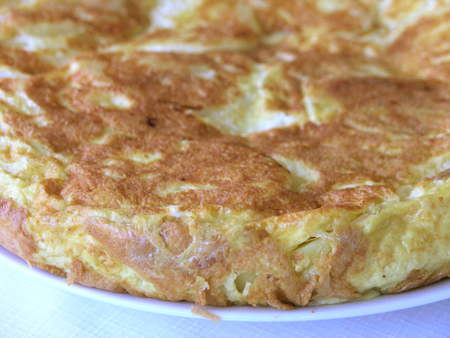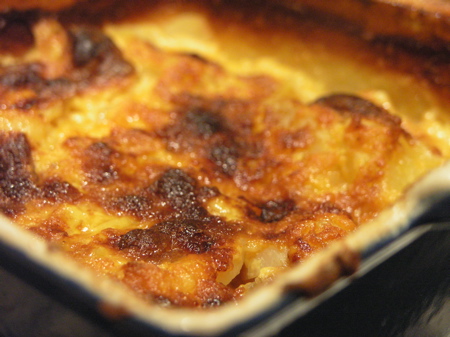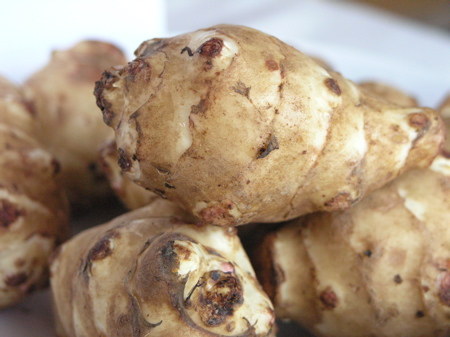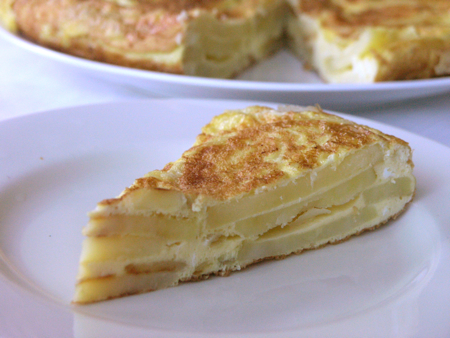
On a recent trip to Spain, I had the chance to sample, once again, one of my favorite Spanish dishes: Tortilla Española, or Spanish tortilla. Here in the US, we associate the word tortilla with that a round flatbread that wraps up a burrito, but in Spain, it refers to an omelette-type dish, eaten in bars, at room temperature during the early-evening snack (tapas) time. I like Spanish Tortilla any time of the day: at brunch, for an afternoon snack, or even for a simple dinner. Cooking it just right can be difficult, though, so I have spent the last few months perfecting mine and now I am ready to share it with all of you.
The Spanish Tortilla enjoys a long history. Throughout the Mediterranean and the Near-East, there are countless variations of what one might call an omelette. It is believed that the dish originated in Persia as the kookoo sabzi and then gradually moved west. In Turkey, it became the kaygana. In Italy, it evolved into the frittata. In France, it became the omelette and in Spain, it is the Tortilla Española or at times, the Tortilla de Patata.
Spanish tortilla is one of those ubiquitous national dishes that inspires strong views on how to make it perfectly and authentically. Of course, because it varies throughout Spain, there is no right answer. I like to make it with a relatively high ratio of eggs to potatoes. I also slice the potatoes thinly using a Mandoline rather than cutting them into cubes. Most recipes you’ll see for Tortilla Española will include onion, and in this version, I have used the more subtle shallot, but I like it with yellow onions as well.
Of course, the biggest question surrounding the preparation of a Spanish Tortilla is whether to flip it or broil it to finish cooking the top side. Traditionalists insist that you must do the flip: slide the tortilla onto a plate, flip it over and slide it back into the pan. But, if you have an ovenproof skillet, you can simply insert the skillet under the broiler and watch carefully while the top finishes.
All of the ingredients below are “to taste.” Do you want the potatoes to crisp up before cooking them in the eggs? Use more oil and crank up the heat for the last few minutes of potato-cooking time. Do you want a heftier dish? Reduce the number of eggs and let the potatoes dominate. Do you want to incorporate more onions into the dish? Finely chop a couple of tablespoons of onions, or shallots, or even leeks, and fry them with the potatoes. The important thing is to experiment until you’ve found your perfect tortilla and then you can have a strong opinion too.
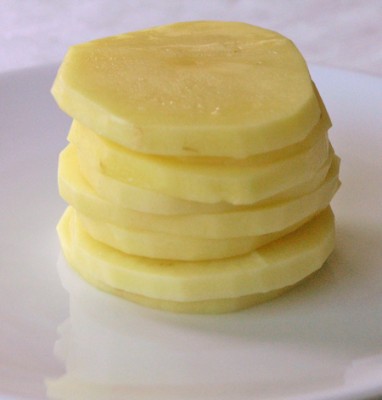
Spanish Tortilla
Serves 8
Ingredients
2 lbs Yukon Gold potatoes (the low starch content keeps them from getting mushy)
¼ cup olive oil (more or less)
½ cup shallots, minced finely
2 tsp salt
Freshly ground pepper
10-12 eggs, beaten
Method
1. Peel potatoes and slice them thinly using a Mandoline if you have one, or a good sharp knife. Sprinkle the potatoes with half of the salt. Over a medium-high flame, heat the oil in a 12-inch sautée pan, preferably one that has sloped sides. Sautée the potatoes and shallots gently until the potatoes are just fork tender, about 25 minutes. Don’t allow them to get too brown. Be patient. It’s important that the potatoes are completely cooked. Remove from heat.
2. Beat the eggs in a large bowl. Add the potatoes and shallots and toss to coat with the eggs. Sprinkle with remaining salt. Wipe out or clean your sautée pan. Add a little bit more oil and heat the pan until very hot. Pour in the egg and potato mixture and let set for about 1-2 minutes. The high heat will help create a layer of cooked egg that will make it easy for the tortilla to slide out of the pan. Once the edges have set, reduce the heat to medium-low and let the mixture cook for 8-12 minutes.
3. When the tortilla is ready to be cooked on the other side, it will be firm on the bottom and still a little runny on top. Slide the pan under a pre-heated broiler and cook until the top has set and just started to brown, about 3 minutes, checking often. If you would like to try the flip instead, invert a plate into the pan, flip it over and then slide the tortilla back into the pan. It’s not as hard as it sounds as long as you have created that cooked egg layer and your pan is not too heavy. Let it cook on the second side for about 3-5 minutes. Then flip back out onto a plate for serving.
4. Once the tortilla has been removed to a serving plate, allow it to cool to room temperature, as it is traditionally served that way. It’s a great dish for parties. To add it to a buffet table, cut it into squares and insert a toothpick to make it easy for guests to enjoy. Yours will look just like the Spanish Tortilla in a tapas bar in Madrid.
